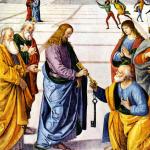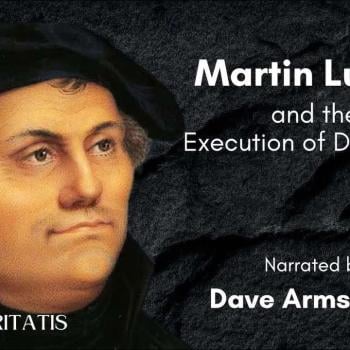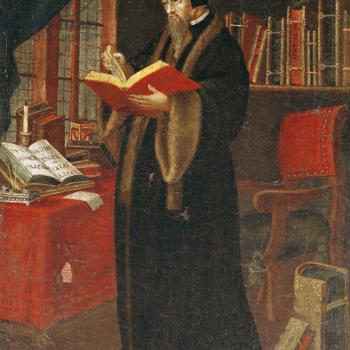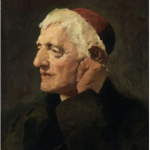The following are excerpts from a two-volume hardcover set that I have in my library: Toleration and the Reformation, by Joseph Lecler, S.J. (New York: Associated Press / London: Longmans, originally 1955; translated by T. L. Westow in 1960); from Volume 1, page numbers provided below.
*****
[p. 202] Persecuted as they were, snice their origin, by Zwingli and his disciples in Switzerland, the Anabaptists soon suffered the same fate in Germany at the hands of both Lutherans and Catholics. . . . In 1530 Sebastian Franck already estimated the number of Anabaptists put to death at two thousand. . . .
[p. 287] On the whole, public opinion, whether Catholic, Lutheran, or Calvinist, did not accept several religions within one State. . . . The degree of desperate intolerance which it reached by the end of the sixteenth century has rarely been surpassed. . . .
The Protestant leaflets abounded in insults directed at the Papacy. The most ignominious assertions were levelled at the Jesuits. They insisted indefatigably that Catholic worship is blasphemy and idolatry, and that it was the Christian prince’s duty to suppress it in his States. In 1576 the Calvinist professor of Heidelberg, Jerome Zanchi, voiced current opinion when he laid [p. 288] down the following points in his explanation of the fourth commandment of the Decalogue:
(1) The devout prince must not, and indeed cannot in conscience, allow his Catholic subjects [ pontificiis ] in his territory to have churches for the practice of their idolatrous worship and the preaching of heretical doctrine. He should rather either destroy those churches with their idols and false worship, or strip them of all their superstitious tools. . . .
(2) The devout prince has the power to force his idolatrous subjects, as Catholics are, to attend orthodox services, but he should see to it beforehand that they are properly instructed by making them renounce impious doctrine and accept sane doctrine. [Opera theologica, t. IV, Geneva, 1613, pp, 799 and 801]
With a curious lack of logic, the Protestant leaflets never ceased to claim freedom of conscience for their co-religionists in Catholic lands, whilst refusing it to Catholics in the States where they were masters. This contradiction was frequently stressed by the Roman controversialists:
In districts dominated by Protestants [wrote George Eder in 1579], Catholics are never tolerated; they are publicly humiliated, driven from their homes and lands, and forced into exile with their wives and children. . . . But as soon as a Catholic member-state of the Empire proceeds in the same way against rebellious and seditious subjects, everyone gets worked up, is indignant, and the Catholic prince is accused of breaking the peace of religion.
But Protestant polemics were not only concerned with the ‘papists’. In Germany Calvinists and Lutherans attacked and tore each other to pieces conscientiously. The Calvinists had nothing but contempt for Lutheran doctrine which they maintained was still infected with papist superstition. The Lutherans could not find words strong enough to stigmatize ‘the satanic brood of Calvin’, the ‘diabolical Calvinists’. the ‘real Mohammedans’. Calvin’s doctrine on Predestination and the Last Supper horrified them. . . . [p. 289] Calvinism is frequently denounced as a foreign product, imported by foreign princes, as for instance, in a pamphlet of 1590:
O Germany . . . Do you not notice the devouring wolves slinking in and preparing a bloodbath for them that hate the satanic poison of Calvin? They desire to hurt you fatally, . . . Germans, when will you ever understand that the Calvinists scorn you and hold you in derision.
. . . With regard to the Calvinists, the Lutherans in Germany were like those in possession who are threatened by a clever and implacable opponent. Whilst they were a minority the Calvinists were charitable and peace-loving; once they held the whip-hand they became extremely intolerant:
As long as the Calvinists are not in power [wrote Daniel Jacobi in 1615], and as long as they are obliged to submit to the existing authority, they are pleasant and patient; they accept life in common with us. But as soon as they are master[s] of the situation, they will not tolerate a single syllable of Lutheran doctrine. Everything must be abolished. . . .
[A]round 1600 the conflict was almost as sharp as between Protestants and Catholics. In 1602 the Lutheran theologian [p. 290] Polycarp Leyser went so far as to say: there is on the whole more common ground between Catholics and the followers of Luther than between the latter and Calvinists. He was horrified by the terrifying God of the Calvinists, which he declared resembled the devil more than the true God! . . .
[p. 311] Various decrees were published [in Zwingli’s Zurich]: in 1524 the suppression of images and statues; in 1525 the suppression of the Mass [p. 312] and the compulsory baptism of infants (aimed against the Anabaptists); . . . lastly (7 March 1526) the death-penalty for anyone who tried to rebaptize [footnote: “. . . In compliance with this law the Anabaptist Felix Manz was drowned on 25 January 1527 . . .”] . . .
[H]e meant to reserve the freedom of preaching of his ‘gospel’ exclusively. Like Luther after the Peasants’ War, he persuaded the public authorities not to tolerate any dissident propaganda on their territory. On 3 January 1527 he wrote to Oecolampadius to ask him to do the same in Basle: “Make the Senate understand how dangerous it is to let people of one town be drawn this way and that by the preaching of divergent doctrines.’ [footnote: “. . . Luther said the same thing . . . in a letter to the prince-elector of Saxony, of 9 February 1526 . . .”] . . .
[p. 313] [Zwingli]:
I know of bishops who will never cease to sow trouble until they meet at last an Elias [Elijah] who pits them to the sword . . . if this same charity commands us to kill them for the well-being of the body, it is better to pluck out a blind eye than to run the risk of losing the whole body.
. . . [p. 314] In 1529 the Secret Council ordered . . . compulsory attendance at the services, and they were forbidden to go to Mass in the neighborhood. . . .
[p. 324] In Geneva, Zurich, and Berne the Anabaptists were exiled without mercy or even put to death. [footnote: “. . . at least forty Anabaptists were executed in Berne between 1528 and 1571 . . .”] . . .
[p. 333] Four months after the execution of Servetus, at the end of January 1554, he [Calvin] published the Declaratio orthodoxae fidei [footnote: “The Latin text appears in Calvini Opera, t. VIII, pp. 453-644 . . .”] . . . It is one of the most frightening treatises ever written to justify the persecution of heretics.. . . In obedience to the Old Testament it may sometimes be necessary to raze whole towns to the ground and to exterminate their inhabitants:
. . . God does not even allow whole towns and populations to be spared, but will have the walls razed and the memory of the inhabitants destroyed and all things frustrated as a sign of his utter detestation, lets the contagion spread. . . . it is here a question of rejecting God and sane doctrine, which perverts and violates every human and divine right. . . .
[p. 334] I ask you, is it reasonable that heretics should be allowed to murder souls and to poison them with their false doctrine, and that we should prevent the sword, contrary to God’s commandment, from touching their bodies, and that the whole Body of Jesus Christ be lacerated that the stench of one rotten member may remain undisturbed?
. . . [A]ccording to Calvin, ‘papists’ do not have the same right to persecute Protestants, since they follow a false doctrine! . . .
[p. 348] In the profession of [p. 349] faith, composed at Geneva in 1560, he [Calvin’s successor Theodore Beza] still protested against those who, out of ‘false clemency’, wanted to save heretics from the magistrate’s sword . . . In a reply of 1563 . . ., Beza showed himself indignant that he and Calvin should be said to have changed their mind in favour of tolerance of dissenters:
Far from us the thought that we would defend that Turkish dogma which holds that everyone can be saved in his own religion, or the Roman dogma that the good intention suffices, or the dogma of Martin Bellius [likely Protestant] that heretics should be left to grow, or that of Castellio [Protestant] that all should be tolerated until the truth appears in a new revelation.
***
Or you may believe my work is worthy to support for the purpose of apologetics and evangelism in general. If so, please seriously consider a much-needed financial contribution. I’m always in need of more funds: especially monthly support. “The laborer is worthy of his wages” (1 Tim 5:18, NKJV). 1 December 2021 was my 20th anniversary as a full-time Catholic apologist, and February 2022 marked the 25th anniversary of my blog.
PayPal donations are the easiest: just send to my email address: [email protected]. You’ll see the term “Catholic Used Book Service”, which is my old side-business. To learn about the different methods of contributing, including 100% tax deduction, etc., see my page: About Catholic Apologist Dave Armstrong / Donation Information. Thanks a million from the bottom of my heart!
***
Photo credit: 12019 (6-10-13) [Pixabay / Pixabay License]
***
Summary: Overview of early Protestant intolerance in matters of religion. Instances of numerous inter-Protestant examples of intolerance are included in the examples.














